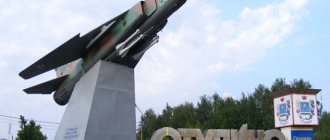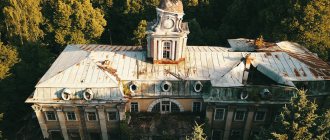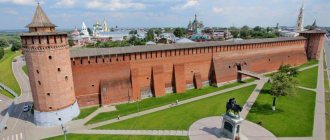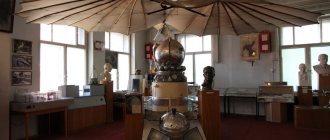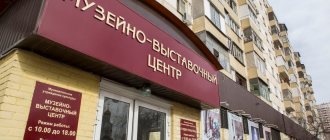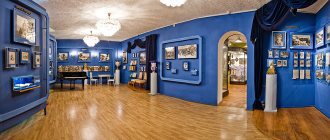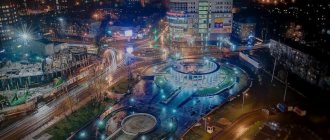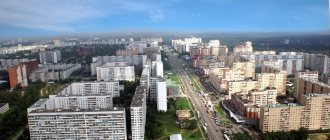Lobnya: what a tourist should see in 1 day
On the territory of Lobnya there are several significant objects from a historical and cultural point of view, for which tourists should visit this city. The most important sights, reflecting the features and specifics of the city, are highlighted at the beginning of the article.
Square of the Defenders of Moscow and the memorial sign “Line of Defense”
- Address: Lenin street.
In Lobnya, much is connected with the Great Patriotic War; the city was awarded the honorary title “Settlement of Military Valor,” which is quite natural. In 1941, fierce battles for the capital were fought on the territory of the city; the last line of defense of Moscow was located 31 kilometers from the Kremlin walls.
Here the Red Army stopped the enemy, preventing him from entering the capital. The city honors the memory of the heroic days of defense and is proud of its historical role, which is reflected in the city’s sights. The “Square of Defenders of Moscow” has been established in the city. Its territory is being actively improved.
As part of the “Line of Defense” project, in the year of the 70th anniversary of the Victory, on July 25, 2015, a memorial sign “Moscow Line of Defense 1941” was installed here. It is a structure of three narrow vertical steles, reminiscent of spears, on which a five-pointed star is mounted, framed by a “St. George’s ribbon”, in the center of which there is an inscription reflecting the name.
Monument "Anti-aircraft gun"
- Address: corner of Batareinaya street and Bukinskoe highway.
Not far from the modern memorial sign, since 1967, there has been the most famous military monument of Lobnya, recognized as an object of historical and cultural heritage of Federal significance.
The monument reminds us of the feat of the 13th battery of the 864th anti-aircraft artillery regiment, whose fighters played an important role in containing the enemy in the battles of December 1-3, 1943.
This information is reflected on the pedestal of the monument, which reproduces an 85-caliber anti-aircraft gun. The creator of the monument is architect I.A. Upland. It was opened on the eve of the 50th anniversary of October.
Church of the Savior Not Made by Hands
- Address: st. Kiovo, 25A.
The oldest monument of church architecture within Lobnya is a legacy of the 18th century. The prehistory of the city of Lobnya goes back to several villages that existed in these lands. One of them was called Kiovo in honor of the local lake.
In this settlement, through the efforts of Count Vorontsov in 1764-1769. A baroque style stone temple was built. According to one version, its architect is Karl Blank, but the name of the architect is not known for certain. The temple, consecrated in honor of the Savior Not Made by Hands, replaced an older wooden church, built back in the 1660s by order of the owner of these lands - B. M. Khitrovo.
In 1900, the Church of the Savior Not Made by Hands underwent reconstruction, in particular, arches were built on the south side. During Soviet times, the temple was closed, its premises were used for economic and industrial needs.
The historical and religious landmark began to perform church functions again in 1988, and restoration was carried out. The temple was given the status of a monument of Federal significance.
Museum of the History of the City of Lobnya
- Address: st. Zhirokhova, 2.
The museum of local history began its history as the Museum of Military and Labor Glory. The initiative to create it was taken by Great Patriotic War veteran Prokopiy Kolychev, an honorary citizen of the city of Lobnya. The exposition opened its doors in 1981.
Military themes still occupy a central place in the exhibition. The “Military Glory” hall is dedicated to the events of the Defense of Moscow and the Great Patriotic War in general, its participants and heroes, where documentary evidence, material sources, and photographs are presented. The main exhibit of the “military section” is considered to be the painting “Fight of Anti-Gunners on December 3, 1941”, written by the artist V. I. Korobkov.
The museum’s permanent exhibition also includes the “History of Neighborhoods” and “Link of Times” halls, dedicated to the culture and life of the inhabitants of the Lobny lands in different eras. The exhibition recreates the interiors of a Russian hut from the early 20th century and a Soviet apartment.
Nature reserve "Lake Kiovo"
- Address: st. Pavlika Morozova, 1.
There is a nature reserve right in the center of the city of Lobnya. The local lake Kiovo received this status in 1947. The object is recognized as a natural monument of Federal significance. This reservoir is an ancient witness to the entire history of the area, reflected in the local toponymy.
Today one of the streets is named after him. The lake is believed to be of glacial origin. One is not large in size, and the maximum depth is comparable to human height - only about 1.7 meters.
The waters are abundantly covered with vegetation. Among the representatives of the fauna, seagulls are considered the most popular inhabitants. Lake Kiovo seems to be a very picturesque and romantic place, a source of pride for locals and one of the points of attraction for tourists.
Don't miss: The best attractions of the Moscow region
It always happened before that when we lived somewhere, we didn’t really explore the city with its attractions, and when driving past some beautiful place we always put off exploring it until later.
The morning pleased us with sunny, warm weather and, having slept well, we leisurely got ready and went for a walk around this city!
of Lobnya itself is a relatively young city. It was founded in 1902 , but became a city only in 1961. In the past, there was a railway station called Lobnya and a station village formed around it, which subsequently grew.
First of all, we go to the Temple of the Archangel Michael in Krasnaya Polyana .
In fact, we are near it almost every other week. It is near this temple that there is a well that we love so much with delicious water that you can drink!
The Church of the Archangel Michael in Krasnaya Polyana was built in 1900 from a small chapel. In appearance, the church is very ordinary, somewhat nondescript. This is not the kind of church that is worth traveling to another city for, although it also has its own characteristics. One of which is a completely transparent, forged bell tower!
A lot of people gather near the temple on Saturdays.
Separately about the well! This is, of course, not a landmark, but a very important element in the city! Residents of Lobnya come here to stock up on water, because it’s simply impossible to drink water from the tap!
There is a private sector around the temple. Purple plums and red rowan are the decorations of these places! We get into the car, turn around and drive on, to the memorial of the years 41-45!
In fact, there are a lot of such memorials in Lobnya . During the Battle of Moscow during the Great Patriotic War, numerous battles with the invaders were fought in the Lobnya area. The village of Krasnaya Polyana, which is part of the city today, is known to us as the point where the enemy came closest to Moscow. The liberation of Krasnaya Polyana is considered a turning point in the battle for Moscow. That's how it is!
We drive up and stop nearby. Here it is, one of the complexes to the glory of the defenders! Numerous names of Lobnen residents are carved on memorial plaques. In the center is a monument to a heroic warrior.
I return to the car. Our path lies to another monument of 1941-1945. We pass by this military weapon every day on the way to work, but we were able to get closer and examine it in detail only today! Russian soldiers are depicted in the background, with a military weapon in the center on a raised platform.
Directly across the road is the Walk of Memory (or Fame). Right across the picturesque bridge there is a recreation area with a children's playground and benches!
The mood is excellent, because summer has spoiled us with another warm day! Here, just recently, I noticed a bench in the shape of a heart right on the shore of the pond. In general, there are a lot of ponds and lakes in Lobnya!
The forged bench is very romantic. There's just a lot of trash around.
After admiring the lake, we moved further - to the temple in the name of the Icon of the Mother of God “Spreader of Bread” . A truly beautiful wooden structure. Everything is so harmonious, dark wood, surrounded by green fields and wild apple trees with red fruits! The temple is very young, built between 1996 and 2001. When we approached it, a service was going on in the temple, cars were driving up. There is a very neat parking lot nearby. The temple is excellent, but the fence around it slightly spoils the overall appearance, although it is painted in the color of the entire composition. And now through Meadow and along Dmitrovka we are again rushing towards Lobnya! A little before reaching the crossing, we turned right - we decided to look at the new microdistrict of the city! The new houses here are impressive - tall, beautiful! We go back and here ahead is probably the most important attraction of the city of Lobnya, because Kiovo is its oldest part, which dates back no less than 5 centuries! The current stone Church of the Savior of the Image Not Made by Hands was erected on October 1, 1769 on the site of a dilapidated wooden church. The temple is very interesting. The round windows are decorated with stucco, endowed with individual characteristics. Previously, the temple was part of the Kiovo-Spasskoye estate , from which now only the garden with the oldest trees and the temple itself remain!
Across the road there is a unique natural reserve - Lake Kiovo!
This lake became a protected lake because of the colonies of seagulls. But they no longer live there, as it seemed to me, and the lake itself is gradually turning into a swamp. But people are walking around here, and the area is apparently being cleaned up.
Returning to the road, we headed to the park of the Kiovo-Spasskoye estate . The park was disappointing. Nothing remained here except ancient trees. But there are a lot of new things - a basketball court, a military glory memorial and an eternal flame. The memorial is very good. Every year of the war is described in detail, there are many photos and family tables.
And we were heading to another body of water in the city, the one near the crossing! A beautiful small pond, a good parking lot near the shore, but the roads... Narrow, one lane, and there is parking on each side. That is, there is only a little space left in the middle for travel! An excavator was driving in front of us... In general, it was interesting to watch how it squeezes among all these parked horses!
Local cats are very charismatic, especially when they take their afternoon baths.
Another local “attraction” is the birch grove recreation park . The central entrance of the park is located from Lenin Street.
We didn’t go to the park itself, since we’d already been there and didn’t see anything particularly remarkable, but there was a very interesting deer standing near the entrance! Right in front of us, two women with their children approached the animal and spent a long time photographing their children! It took a long time because each of them climbed onto the back of a fragile animal! This is one of the first walks around our city, this is how I see Lobnya, perhaps in the future I will see it a little differently.
Similar articles:
- 05/09/2016 - May 9 in the city of Lobnya
- 06/12/2012 - Hero City Smolensk! The first day
- 06/09/2012 - On the way to Smolensk - amazing Smogiri
- 06/09/2012 - On the way to Smolensk - Mozhaisk and Vyazma
- 08/22/2015 — A short trip to Zosimova Pustyn
© Website “Across Russia by car” https://bycarinrussia.ru. Copying text and photos only with the permission of the author. All rights reserved.
Similar articles:
- 05/09/2016 - May 9 in the city of Lobnya
- 06/12/2012 - Hero City Smolensk! The first day
- 06/09/2012 - On the way to Smolensk - amazing Smogiri
- 06/09/2012 - On the way to Smolensk - Mozhaisk and Vyazma
- 08/22/2015 — A short trip to Zosimova Pustyn
Historical and architectural sights
Lobnya has had the status of a city since 1961. The official date of its foundation is 1902, but the development and settlement of these lands goes back to time immemorial. Consequently, in the city and its surroundings you can find interesting architecture, against which you will get memorable photographs.
Kiovo-Spasskoye Estate
- Address: Kiovo street, 17B.
The Spasskaya Church, preserved and now functioning, was part of the Spasskoe-Kiovo estate complex. The history of the estate can be traced back to 1623, when these lands were transferred into the ownership of the brothers Ivan and Grigory Bornyakov. Later the owners of the estate were B.M. Khitrovo, I.M. Yazykov, princes of Volyn, I.I. Vorontsov. From the middle of the 19th century until the revolution it belonged to Count Panin.
Not much remains today from the centuries-old history of the estate. The regular manor park, laid out in the 18th century, has not been completely preserved. From the estate buildings, a one-story outbuilding has survived to this day - a white stone structure with symmetrical facades and a gable roof.
Stylistically, it correlates with classicism, although a number of sources indicate that the building does not have clearly defined features of a specific architectural style. Dates from the beginning of the 19th century. The territory of the estate is an object of historical and cultural heritage of regional significance.
Buildings of the Krestovnikov factory
- Address: microdistrict Krasnaya Polyana.
As part of the modern city of Lobnya there is a microdistrict of the same name to the famous Sochi resort - Krasnaya Polyana, historically it was the village of Polyany, in the Soviet pre-war period - the village of Krasnaya Polyana. The legendary local textile factory received the same name; it is considered the oldest enterprise in the city.
The settlement, which has become a microdistrict, has a long industrial history. Back in 1850, in the village of Polyany, the famous industrialists the Krestovnikov brothers created a paper factory. The production buildings of the former factory - red brick buildings, built in the spirit of the times - are a historical and industrial landmark of Lobnya.
Shukhov hyperboloid water tower
- Address: 21, bldg. 1, Science Town.
The name of the designer Vladimir Grigorievich Shukhov was imprinted on the appearance of many cities in our country, thanks to the tower project he developed. The most famous of the Shukhov towers is located on Shabolovka in Moscow.
Once there were about 200 Shukhov towers across the country, but only seven have survived to this day, and one of them is in Lobnya. It was built in 1918.
The characteristic openwork design of the tower is 40 meters high; the tank holds 100 cubic meters of water. At the moment it is not used for its intended purpose and is preserved as a historical and engineering landmark.
Village "Katyushki"
- Address: Katyushki street, 43B.
The former village of Katyushki is now the urban microdistrict of Lobnya. In the northeast of it, on the right bank of the Lobnya River, archaeological excavations were carried out, during which finds were made dating back to different historical periods. The settlement discovered here in 2008 was recognized as a cultural heritage site.
The dating of the monument is approximate. It is believed that the settlement arose no earlier than the 14th century, and its dawn came in the 17th century. A characteristic feature of the village is a pond with a diameter of 50 meters. Scientists have determined that this is an artificial object.
Settlement "Lugovaya"
- Address: Lugovaya village.
An archaeological site on the territory of the former village of Lugovaya, now a district within the city, was discovered in 2013. The village dates back to the 15th-16th centuries. Fragments of ceramics characteristic of that time were discovered.
Tourist on a moped
I ended up in Lobnya on business. But to find myself in a city where I have never been before and not get to know the local attractions? No, it's not for me…
So, on the morning of April 7, 2016, I took the train to Lobnya, a town near Moscow, located on the Moscow-Savelovo railway line. By 11 o'clock the business was over and it was possible to recover ahead of time, using the Internet, with the route drawn up: Lake Kiovo - st. Zheleznodorozhnaya – st. Battery - Memorial to the Defenders of Moscow - All-Russian Research Institute of Feeds named after. Williams - Lugovaya railway station .
The first point of my walk is Lake Kiovo . The lake was once called by another name - Kiyovo, Kiovskoye. What is interesting about this lake? — It is home to the largest colony of black-headed gulls in the Moscow region. It is difficult to find a resident of central Russia who does not know these birds. On any larger or smaller freshwater body of water you can find black-headed gulls. And they are frequent guests at coastal landfills. It would seem, what could be interesting in a colony of well-known birds? But there really are a lot of seagulls on Lake Kiovo. And in full accordance with the laws of dialectics, quantity turns into quality. When you walk along the shore of Lake Kiovo and see a mass of seagulls above the lake, hear their incessant cries, you can imagine that you are not in the Moscow region, but in the middle of a bird market somewhere on the Commander Islands...
The southern part of the lake is very swampy. Overgrown with grass, bushes and, in some places, even trees.
This is where seagulls mainly nest. By the way, the seagull is a symbol of Lobnya. She is depicted on both the flag and the city's coat of arms.
Among the reeds and cattails there are some strange lattice pyramids. I don’t understand why they are needed, but apparently they are somehow connected with the nesting of seagulls.
Among the seagulls there are also a few ducks.
The central and northern parts of the lake are free of vegetation.
On the other side of the lake stands the Spasskaya Church, built in 1763 - 1769. The church was built in the style of the so-called “Russian Baroque” (also known as “Moscow Baroque”, “Naryshkin Baroque”) by the famous Moscow architect K. I. Blank.
A sign of spring - willow begins to bloom on the shore of the lake.
I note that as soon as I went to Lake Kiovo, it started to rain. Because of this, the quality of the images leaves much to be desired. But, despite the bad weather, I enjoyed the walk along the shores of the lake. The gloomy sky, lakes and swamps, the cries of seagulls - all this creates a special mood. A kind of “romance of the north”.
If I had gotten to Lake Kiovo not at the beginning of April, but a few weeks earlier, I would hardly have been able to see the seagulls. In old guidebooks they write: “Every year in early spring, at the end of March - beginning of April, they [seagulls] fly to the lake. At this time, seagulls are especially careful. The slightest noise, the crunch of snow or ice makes them take off and rise upward. At the end of April, when life awakens on the lake, you can hear piercing bird calls, watch quarrels, and fights between seagulls. This is a struggle for a place on the floodplain, where at this time nests are being built, and then eggs are laid. Chicks appear at the end of May - beginning of June. A month later, groups of young birds roam the floodplains in search of food. At this time, they can already feed themselves on the lake and in the nearest meadows. Soon, in mid-June, adult gulls gradually fly to other bodies of water and never return to the lake. Young, strong gulls fly away from the lake in small flocks from the first days of August. They lead a nomadic life in nearby bodies of water, first returning to spend the night on the lake, and then flying further. Next spring they will fly here again to nest. The birds are protected here: they are “patronized” by local pioneer schoolchildren.” (“Memorable places of the Moscow region”, M., “Moscow Worker”, 1956, p. 471).
Getting to Lake Kiovo is very easy. Arriving from Moscow at the Lobnya railway station, we go out on the right side of the train. We find ourselves on Zheleznodorozhnaya Street. We stand with our backs to the railway. You can go right to the nearest intersection, where you turn left. This will take us to the southern part of the lake. If, on the contrary, you go left along Zheleznodorozhnaya Street and then turn right at the intersection, you can get to the central part of the lake. The walk doesn't take long - it's less than a kilometer from the station to the lake.
After examining the lake, he returned to Zheleznodorozhnaya Street. From there I turned left onto Batareinaya Street. I crossed a railway crossing and, soon, on the left side of the road I saw the Memorial to the Defenders of Moscow in 1941 . Fascist tanks were stopped here. The enemy did not get further.
Learn more about the battles that took place here. “At the end of 1941, the Nazis, at the cost of huge losses, managed to reach the Lobnya area. A serious threat loomed over Moscow, and fierce battles broke out at this line of defense of our troops. On December 1, a column of fascist tanks from the area of the village of Gorki launched an attack on Lobnya. They were met with fire from anti-aircraft gunners. In this battle, soldiers of the 13th battery of the 864th anti-aircraft artillery regiment of the 1st air defense corps distinguished themselves. Powerful anti-aircraft fire stopped the enemy. The Nazis retreated. A day later they repeated their attempt to attack. Enemy tanks began to descend into the ravine from the village of Nesterikhi, now within the city limits. The heroic anti-aircraft gunners fought steadfastly against the Nazis. One after another, enemy tanks failed, and the enemy retreated. Now a monument has been erected at the site of the battle - an anti-aircraft gun on a pedestal.” (V.I. Popadeikin, V.V. Strukov, A.M. Tarunov “Paths of the Moscow Region”, M., “Moscow Worker”, 1989, p. 46).
100 meters east of the anti-aircraft gun there is a preserved section of the anti-tank ditch and, next to it, a memorial sign.
The moat is a unique sight for such memorials. You can see guns and tanks on pedestals everywhere, but this was the first time I saw an anti-tank ditch as part of the memorial. True, since childhood I have seen enough of anti-tank ditches in the vicinity of my dacha, but for young people, I think it will be interesting to visit the memorial in Lobnya to see what an anti-tank ditch during the Great Patriotic War looked like.
Naturally, I wanted to take a picture of the ditch, but, after thinking about it, I decided not to do it. It’s a very unsightly sight – the banks of the ditch are very littered! The snow melted and exposed all the rubbish that the city residents had dumped here over the winter... But not only the anti-tank ditch is littered with rubbish. And in general, Lobnya, compared to Moscow, gives the impression of a poorly cleaned city. Garbage on the shore of Lake Kiovo, garbage in the backyards of the houses surrounding the lake... Of course, the city administration can refer to a lack of funds for improvement. So the complaints, first of all, are not against the city administration, but against the residents. Why spoil where you yourself live? Of course, not all Lobny residents litter everywhere. And someone is cleaning up their hometown. So, I came across an announcement about an upcoming cleanup day at Lake Kiovo. I couldn’t help but remember the joke that “on a cleanup day, those who never litter clean up after those who constantly do it.”
Anyway, enough about the trash. Let's get back to my walk. Having walked to the end of Batareinaya Street, I turned right, in the direction of the Williams All-Russian Research Institute of Feed . As before, in the light rain I walked along the side of the highway. A car in the same direction stopped nearby. The driver offered me a ride. Yes... You won’t find this in the capital, but in the provinces - please! But it was not far to the Feed Institute and, having sincerely thanked the driver, I continued on foot.
Soon the territory of the institute appeared.
Perhaps it’s time to explain to the reader why I needed the Feed Institute. The fact is that on the territory of the institute there is a unique structure - a steel openwork mesh water tower, built according to the design of engineer V.G. Shukhova. Yes, yes, the same Shukhov who designed the tower on Shabolovka in Moscow.
The Lobnenskaya Tower was built in 1918 specifically for the Institute of Meadow Growing (later the Institute of Forage). The water tower is currently not working. But it is included in the list of historical values and is one of seven surviving objects built under the leadership of an outstanding engineer.
I tried to capture the tower from different angles.
One of my friends said that this tower reminds him of the tower from the planet Saraksh, from the movie “Inhabited Island”. I remembered the battle towers with hyperboloids, on the island and the yacht, in the movie “Engineer Garin’s Hyperboloid”.
Those who go to see the tower, please note that the tower is not very high. Don't expect anything grand like the Shukhov Tower in Moscow.
But next to the water tower there is an An-2 plane.
These multi-purpose aircraft are widely used in agricultural aviation. Therefore, the An-2 monument aircraft is very appropriate at the Institute of Feed. The first An-2 flight took place back in 1947, but as of 2012, 2,271 An-2s were still in operation around the world, of which 1,683 were in Russia. Many aircraft have been flying for more than 40 years and some of them have flown more than 20 thousand hours. The An-2 was produced in the USSR, Poland, and China. By the way, it seems that this aircraft continues to be produced in China. At least in 2012 the Chinese were still making them.
So, all the planned sights have been explored, it’s time to return home. On the way to the Lugovaya railway station I observed a picture of the spring flood.
Station buildings. Probably since the 30s of the last century...
In Lobnya there are, of course, other attractions besides those that I visited. But you can’t visit everything in one day, you have to choose something. Perhaps someone will prefer the numerous museums of Lobnya, or, for example, theaters, of which there are even two in the city. In any case, I wish everyone interesting walks!
Cultural life of Lobnya: museums, theaters, recreation centers
Everyone will also be able to have a cultural holiday in Lobnya – both tourists and citizens. In addition to the local history museum, there are galleries, permanent exhibitions and theaters.
Art Gallery
- Address: Lenin street, 16.
Honored Artist of Russia Vladimir Ivanovich Korobkov left a noticeable mark on the culture of the city of Lobnya and is the author of heraldic symbols. It was thanks to him that the Art Gallery appeared in Lobnya in 2004. He himself was its first director.
Over the years of its existence, the gallery has become an exhibition platform for more than 100 artists and a venue for cultural and educational events. In particular, the local history seminar “History of the city about the people and for the people” is taking place within its walls.
Soil and Agronomic Museum named after. V.R. Williams
- Address: k1, Science Town.
Arriving in Lobnya, you have the opportunity to go on a unique excursion that will interest everyone who is passionate about agriculture. The city is home to a famous scientific institution - the All-Russian Institute of Feed, named after the famous soil scientist Vasily Robertovich Williams.
The institution operates a “Soil and Agronomic Museum”, which presents materials on biology, geography and ecology, which will be an excellent addition to school and university courses, and for adult tourists will significantly broaden their horizons.
Part of the exhibition is dedicated to the life and work of Williams himself. The museum has a fairly long history; it was officially opened in 1934. The basis of the exhibition was made up of exhibits collected in the century before last, starting from the 1880s.
Theater "Chamber Stage"
- Address: Bukinskoye sh., 31.
The Municipal Drama Theater "Chamber Stage" is one of the most famous cultural institutions of the city, dating back to 1991. The repertoire includes productions aimed at audiences of different ages. The theater is the venue for the annual Russian Classics festival. Troupes from different cities of Russia and foreign groups take part in it.
Theater "Dolls and People"
- Address: Lobnensky Blvd., 9A.
Little spectators and their parents will be warmly welcomed in the cozy hall of the Lobnya puppet theater. The institution sees its mission as “helping adults answer children’s questions.” The theater opened its doors in 1991.
The creation of the theater is associated with the name of the artist, designer and architect Olga Kirillova, she was also its first director. The repertoire includes puppet shows not only for children; there are also serious productions for adults.
House of Culture "Krasnaya Polyana"
- Address: Sportivnaya st., 4.
The House of Culture, created at the Krasnaya Polyana textile factory, has the status of the oldest cultural institution in the city. It was opened in 1928. The building was built according to a standard design and has historical significance associated with the Great Patriotic War.
A people's militia was formed here; people went to the front directly from the building of the Palace of Culture. This fact is recorded on a memorial plaque installed on the facade.
Nowadays the Krasnaya Polyana cultural center is a whole leisure complex. In addition to the concert venue, there is a play center for children called “Fidgets” within its walls, and there is a gym and a gym.
On the basis of the institution there are clubs, sections, and interest clubs. The House of Culture has become a popular place for holding events of various levels - these include events that are significant for the city, and private banquets on special occasions.
House of Culture "Lugovaya"
- Address: 1B, Scientific Town.
The House of Culture, created at the Williams Research Institute, is located on the territory of the scientific town. Operating since 1974. Known as a center for children's and youth creativity. This is a place for creative realization, additional education, and a pleasant pastime.
Vocal, dance and theater groups, both children's and adults, operate at the cultural center. Various classes are offered for the younger generation, from aerobics to English language courses.
Temples and churches of the city in the vicinity of Lobnya
In Lobnya there are several Orthodox churches that were created or acquired their current appearance already in the era of modern Russia.
Michael the Archangel Church
- Address: st. Lieutenant Boyko, 41A.
In 1861, to commemorate the abolition of serfdom, the factory owners, the Krestovnikov brothers, organized the construction of a chapel in Krasnaya Polyana. It was closed under Soviet rule. Already in the 1990s, the rear of the former chapel was rebuilt, turning into a functioning temple, consecrated in honor of Michael the Archangel.
Temple of Philaret of Moscow
- Address: st. Kalinina, 11.
In honor of Moscow Metropolitan Philaret, a small remarkable church was consecrated in Lobnya, attracting with its rounded shape and shiny silver dome. This is a modern era structure. The church was built in 1996-2001.
Temple of the Icon of the Mother of God “Spreader of the Loaves”
- Address: Polevaya st., 7A, Lugovaya microdistrict.
The cozy wooden church in the Lugovaya microdistrict externally resembles examples of ancient Russian architecture, however, it is a modern building. The initiative to build the temple was expressed by local residents in 2003. The temple was consecrated in 2010 in honor of the “Different of the Loaves” icon.
Monuments and sculptural decorations of the city
For historical reasons, all the significant and most famous monuments in the city of Lobnya are dedicated to military themes.
Mass grave "Belfry"
- Address: City Park of Culture and Leisure.
The memorial appeared in the western part of the Park of Culture and Leisure in the year of the 55th anniversary of the Victory. The remains of Soviet soldiers discovered at the construction site of a new microdistrict were reburied here.
Erected on May 8, 2000, the monument is a granite arch topped with an Orthodox cross. It was called "Belfry". Today it is positioned as a memorial to all those who died in wars and military conflicts of the 20th century.
Obelisk "Soldier of 1941"
- Address: South Street.
The figure of a Soviet soldier was installed in the Lugovaya microdistrict in memory of the events of December 6, 1941, when the 35th Infantry Division went on the offensive near Lobnya. Historical circumstances are recorded in the inscription on the pedestal.
Stella "To the Pacific Sailors..."
- Address: Moscow Defenders Square.
Among the military units defending Moscow were sailors - a brigade formed from soldiers of the Pacific Fleet. One of the monuments in the “Square of Moscow Defenders” is dedicated to them.
The stele was installed in 1986 through the efforts of the Pacific Fleet Veterans Council. The full name of the Monument is “To the Pacific sailors and Siberian Red Army soldiers who stood to the death at the line of Lobnya in the great battle for Moscow.”
Memorial "Eternal Flame"
- Address: Krasnaya Polyana microdistrict.
On the site of the mass grave between the former villages of Krasnaya Polyana and Puchkovo there is an extensive military memorial that dates back to the 1950s. Its author and initiator of creation was N. Shishkov, an eyewitness to the battles for Moscow.
More than 1,200 soldiers are buried in a mass grave on Puchkovo Field. The names of those who were identified are engraved on the slabs behind the statue of the soldier, the central figure of the memorial. At the foot of the monument the Eternal Flame burns.
Monument "Lorry". Car ZIS-5
- Address: Bukinskoye sh., 39.
In 1984, the legendary ZIS-5 car was placed on a pedestal in Lobnya. Such cars were manufactured in the 30s and were reliable “iron horses” for military drivers of the Great Patriotic War.
The vehicle that became a monument previously belonged to front-line soldier A. Akkuratov. The car was restored by him and was running. The monument was initially christened “Veteran Car of 1943”, then the inscription was shortened to “Veteran-1943”, and the monument began to be called “Lorry”.
Monument to children prisoners of fascism
- Address: City Park of Culture and Leisure.
Two small emaciated children's figures - a boy and a girl - are one of the most touching and poignant military monuments of Lobnya, installed in 2015. It is dedicated to young prisoners of fascist camps. In the images of children, sculptor Dmitry Yamin managed to convey all the pain and hardships of the war.
Lobnensky parks and squares
For walks in Lobnya, the local recreation center is perfect, however, if you wish, you can always go a little further, to the Lobnya Forest Park, where unity with nature is more significant.
Park of Culture and Leisure in Lobnya
- Coordinates on the map: 56.013290, 37.471254.
Lobnensky Cultural Park is one of the most recognizable places in the city, a popular venue for events and an area for recreation and entertainment for citizens.
The park has picturesque alleys with flower beds, gazebos, and park sculptures. The infrastructure pays attention to sports; playgrounds and paths for cycling and roller skating are equipped; in the winter, the park attracts skiers. There are separate areas for walking and training dogs.
There is a pond on the territory where a popular water attraction operates. The park also offers other entertainment aimed at both children and adults.
AyLe.ru recommends visiting:
2 (1 rating)
An extraordinary journey to “The Embrace of the Marvelous Zamoskvorechye”
3 (1 rating)
Education
1 (1 rating)
Birthday party on hoverboards, Segways, unicycles!
1 (1 rating)
Exhibition “Aristocrats of the Seas”
3.5 (6 ratings)
Every 7th lunch is free!
5 (1 rating)
54th Antique Market “Flea”
AyLe.ru – current information about entertainment in Lobnya: addresses, phone numbers and brief descriptions of organizations on the city map. Here you will find all the cafes, restaurants, bars where you can eat deliciously and inexpensively, with a convenient search on the map or by type of cuisine.
If you haven’t yet decided where to go and what to do in Lobnya, our site will help you figure out how to spend your time or relax in an interesting and useful way. Here are the addresses and contacts of popular entertainment in Lobnya. All information is presented in specialized sections that allow you to quickly find both inexpensive entertainment and choose unusual and even extreme adventures.
